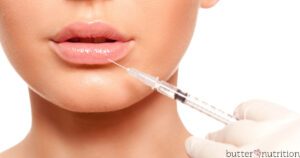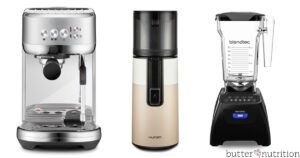Selenium is an important and powerful mineral that you may not have heard much about. It doesn't get nearly as much attention as b-vitamins, zinc or vitamin C, but that needs to change.
Read on to find out all the important cliff notes that are essential to optimizing your selenium status.
Signs of selenium deficiency:
If some of the symptoms below are familiar to you, it may warrant checking your selenium levels:
- IBD
- Crohns
- cardiovascular diseases
- infertility
- myodegenerative disorders
- cognitive decline
- poor immune function
- thyroid dysfunction
- increased susceptibility to infection
- inflammation
- skin abnormalities
- loss of pigmentation of hair and skin [1,2,3,4]
Role of selenium
The perks of optimizing selenium levels are plentiful. While selenium is perhaps most known for being a key ingredient to help your body make glutathione peroxidase, the master antioxidant in the body that combats oxidative stress, it also supports detoxification, gut and skin health.
Selenium is a cholagogic mineral, meaning it can help increase bile flow. This supports better detoxification and elimination (read: helps your body take out the trash and assists in reducing constipation). Poor bile flow, from a lack of bile building nutrients , dietary co-factors and/or Rx medications is extremely common and leads to increased toxicity in the body. This is because when your bile flow is inadequate, you're more likely to accumulate bodily 'trash' faster than you're capable of getting rid it. Over time this can lead to increased inflammation, fatigue, weight gain and malaise.
A deficiency of selenium is also linked to Inflammatory Bowel Disease (IBD): "Selenium deficiency is a common finding in patients with IBD and correlates with disease severity. In addition, patients with IBD have a lower abundance of protective gut microbiota, and selenium can increase it". [10]
Other benefits of selenium include supporting skin health, as it's been proposed as a nutrient that can fight psoriasis and skin cancer. [9]
How to get more in your diet
The Recommended Dietary Allowance (RDA) for selenium in adults is 55 micrograms (mcg), with a safe upper limit of 400 mcg.
Getting more selenium in your diet can be tricky, especially if you have any nutrient excess influencing your dietary choices.
For instance, several high selenium foods are high in copper or vitamin A, which could be a conflict of interest when trying to easily increase selenium levels with food. [7]
- brazil nuts, 1 ounce: 989% daily value*
- yellowfin tuna, 3 ounces: 167% daily value***
- sardines, canned in oil with bone, 3 ounces: 82% daily value
- ham, 3 ounces: 76% daily value**
- roasted turkey, 3 ounces: 56% daily value
- cottage cheese (1%), 1 cup: 36% daily value
- ground beef, 25% fat, 3 ounces: 33% daily value
- egg, one: 27% daily value**
- regular quick oatmeal, 1 cup prepared: 24% daily value
*denotes high copper food
**denotes high vitamin A food
***denotes high mercury food
Supplements for selenium deficiency
Supplements for selenium can be tricky.
While it can be a better route for those who have a hard time loading up on high selenium foods due to dietary restrictions, it's common to have reactions to selenium supplementation. This is because selenium is a potent mineral and food is just so much better tolerated than supplemental sources. That said, always start low and slow with selenium supplementation to avoid taking more than your body can handle.
There are two main forms of selenium found in supplements, selenium selenite and selenomethionine. Research suggests that 90% of selenomethionine (this is the form found in animal tissue) is absorbed in humans verses only around 50% of the selenium from selenite. [9]
Supplementation based on testing is always the way to go since selenium toxicity is also something you want to avoid. Common signs of toxicity include garlic breath, skin lesions, and brittle hair and nails. [9]
Testing for selenium deficiency
When it comes to assessing selenium levels in my clients around the world, hair tissue mineral analysis is my go-to. Using a small hair sample, you can discover your selenium level along with 34 other minerals. The balance of these minerals is key (no deficiency or excess) for optimal health and so you can target your symptoms from a holistic nutrition perspective.
Ready to find out your selenium level?
Get started right away here or enter your email below to learn all about the best way to understand your own mineral levels with hair analysis.
Are your selenium levels falling short? Please share in the comments!
PIN IT:
References:
- https://pubmed.ncbi.nlm.nih.gov/29489289/#:~:text=Research%20suggests%20that%20selenium%20deficiency,myodegenerative%20disorders%2C%20and%20cognitive%20decline.
- https://pubmed.ncbi.nlm.nih.gov/22381456/
- https://pubmed.ncbi.nlm.nih.gov/36768955/
- https://pubmed.ncbi.nlm.nih.gov/31078905/
- https://pubmed.ncbi.nlm.nih.gov/35874733/
- https://www.sciencedirect.com/topics/nursing-and-health-professions/selenium-deficiency
- https://ods.od.nih.gov/factsheets/Selenium-HealthProfessional/
- https://pubmed.ncbi.nlm.nih.gov/982619/
- https://www.mdpi.com/1422-0067/19/10/3059
- https://www.sciencedirect.com/science/article/abs/pii/S0899900721000150









Join the Conversation